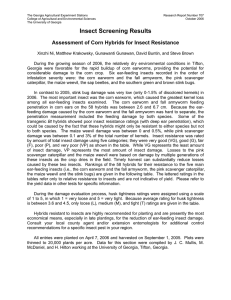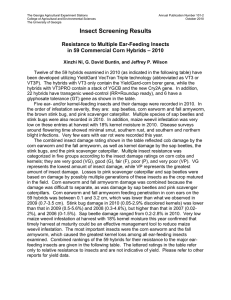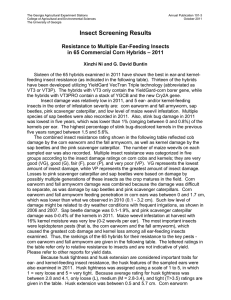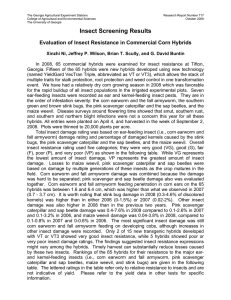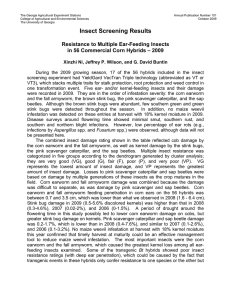Document 13150860
advertisement
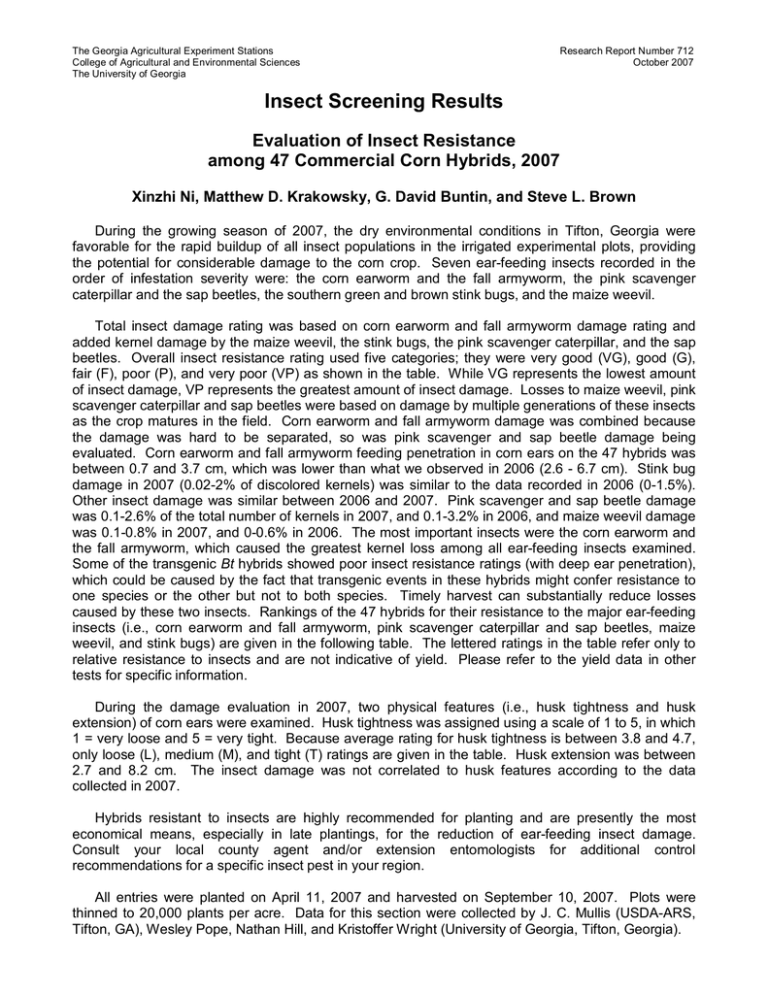
The Georgia Agricultural Experiment Stations College of Agricultural and Environmental Sciences The University of Georgia Research Report Number 712 October 2007 Insect Screening Results Evaluation of Insect Resistance among 47 Commercial Corn Hybrids, 2007 Xinzhi Ni, Matthew D. Krakowsky, G. David Buntin, and Steve L. Brown During the growing season of 2007, the dry environmental conditions in Tifton, Georgia were favorable for the rapid buildup of all insect populations in the irrigated experimental plots, providing the potential for considerable damage to the corn crop. Seven ear­feeding insects recorded in the order of infestation severity were: the corn earworm and the fall armyworm, the pink scavenger caterpillar and the sap beetles, the southern green and brown stink bugs, and the maize weevil. Total insect damage rating was based on corn earworm and fall armyworm damage rating and added kernel damage by the maize weevil, the stink bugs, the pink scavenger caterpillar, and the sap beetles. Overall insect resistance rating used five categories; they were very good (VG), good (G), fair (F), poor (P), and very poor (VP) as shown in the table. While VG represents the lowest amount of insect damage, VP represents the greatest amount of insect damage. Losses to maize weevil, pink scavenger caterpillar and sap beetles were based on damage by multiple generations of these insects as the crop matures in the field. Corn earworm and fall armyworm damage was combined because the damage was hard to be separated, so was pink scavenger and sap beetle damage being evaluated. Corn earworm and fall armyworm feeding penetration in corn ears on the 47 hybrids was between 0.7 and 3.7 cm, which was lower than what we observed in 2006 (2.6 ­ 6.7 cm). Stink bug damage in 2007 (0.02­2% of discolored kernels) was similar to the data recorded in 2006 (0­1.5%). Other insect damage was similar between 2006 and 2007. Pink scavenger and sap beetle damage was 0.1­2.6% of the total number of kernels in 2007, and 0.1­3.2% in 2006, and maize weevil damage was 0.1­0.8% in 2007, and 0­0.6% in 2006. The most important insects were the corn earworm and the fall armyworm, which caused the greatest kernel loss among all ear­feeding insects examined. Some of the transgenic Bt hybrids showed poor insect resistance ratings (with deep ear penetration), which could be caused by the fact that transgenic events in these hybrids might confer resistance to one species or the other but not to both species. Timely harvest can substantially reduce losses caused by these two insects. Rankings of the 47 hybrids for their resistance to the major ear­feeding insects (i.e., corn earworm and fall armyworm, pink scavenger caterpillar and sap beetles, maize weevil, and stink bugs) are given in the following table. The lettered ratings in the table refer only to relative resistance to insects and are not indicative of yield. Please refer to the yield data in other tests for specific information. During the damage evaluation in 2007, two physical features (i.e., husk tightness and husk extension) of corn ears were examined. Husk tightness was assigned using a scale of 1 to 5, in which 1 = very loose and 5 = very tight. Because average rating for husk tightness is between 3.8 and 4.7, only loose (L), medium (M), and tight (T) ratings are given in the table. Husk extension was between 2.7 and 8.2 cm. The insect damage was not correlated to husk features according to the data collected in 2007. Hybrids resistant to insects are highly recommended for planting and are presently the most economical means, especially in late plantings, for the reduction of ear­feeding insect damage. Consult your local county agent and/or extension entomologists for additional control recommendations for a specific insect pest in your region. All entries were planted on April 11, 2007 and harvested on September 10, 2007. Plots were thinned to 20,000 plants per acre. Data for this section were collected by J. C. Mullis (USDA­ARS, Tifton, GA), Wesley Pope, Nathan Hill, and Kristoffer Wright (University of Georgia, Tifton, Georgia). Tifton, Georgia: Evaluations of Corn Hybrids for Resistance to Insects and Related Traits, 2007 Overall Resistance 3 to Insect Injury 2 or more years 2007 Company or Brand Name Hybrid Name Days to Antheses Husk Extension cm Husk 2 Tightness Croplan DynaGro Greenwood Greenwood Croplan 751RR2 58P60 TL3450RR TL3550YGCBRR 6831TS 61 60 61 62 58 5.7 4.6 5.3 6.2 5.3 M M L M M VG VG VG VG VG Agratech Agratech Agratech DeKalb Pioneer 7754 695RR 845RR DK69­43­RR2 33M57(Hx1/LL/RR2) 59 60 62 58 62 6.5 4.3 5.1 5.0 3.4 M M M M M VG G G G G Pioneer Croplan NK Agratech Agratech 33V16(YGCB/RR2) 6818TS N77­P5 7907RR 897RR 61 60 59 58 61 5.8 6.6 7.0 3.7 4.0 L M T T M G G G G G 2842RRBUS 2989RRB 8295YG1/RR 31P41 8247YG1 62 64 59 61 60 4.1 3.3 5.7 6.5 2.7 M T M M M G G F F F DKC67­23(RR2/YGCB) 799RR2 DK65­47RR2 DK6787 RR2/YGCB 851RR2/Bt 59 61 58 61 62 6.1 6.4 5.2 6.5 4.2 T M T M M F F F F F P DeKalb Pioneer Greenwood Croplan Agratech DK66­23 RR2/YGCB 31N28(YGCB) TL3525YGCBRR 8702RH 797RR 59 60 63 62 64 6.3 4.5 5.6 5.0 6.4 L M M M M F F F F P P DeKalb DeKalb DeKalb Croplan Croplan DK61­73 RR2/YGCB DK63­46 RR2/YGCB DK64­27RR2 8950RR2/Bt 7505RR2 58 59 58 60 58 4.7 4.3 4.7 7.0 5.7 L M L T M P P P F F Agratech Agratech DynaGro Agratech Pioneer 7901 7177 CX0657 7694 31G65(RR2) 59 60 64 60 62 8.2 3.9 3.3 6.1 7.0 M M M L M F F F F P Golden Acres Golden Acres Garst Pioneer Garst DeKalb Croplan DeKalb DeKalb Croplan 1 G G G G G F F F Tifton, Georgia: Evaluations of Corn Hybrids for Resistance to Insects and Related Traits, 2007 (Continued) Overall Resistance 3 to Insect Injury 2 or more years 2007 Company or Brand Name Hybrid Name Days to Antheses Husk Extension cm Husk 2 Tightness SS Agratech Greenwood DeKalb Pioneer 731CL 7711RR GW775 DKC69­71(RR2/YGCB) 31D58 60 61 60 62 62 6.2 6.8 3.4 6.2 6.4 T T M T M P P P VP VP SS783RR2YGCB 7801 61 59 6.2 5.4 M L VP VP SS Agratech 1 G F P All data in this table were collected from four replications. 1. The bolded entries have been examined for two or more years at Tifton, GA. 2. L = loose husks, M = medium­tight husks, and T = tight husks. 3. Overall insect resistance to ear­feeding insects (i.e., the corn earworm, the fall armyworm, the pink scavenger caterpillar, the maize weevil, and the stink bugs). Insect resistance measured by the of kernels infested with the ear­feeding insects from five ears, where VG = very good, G = good, F= fair, P = poor, and VP = very poor.
